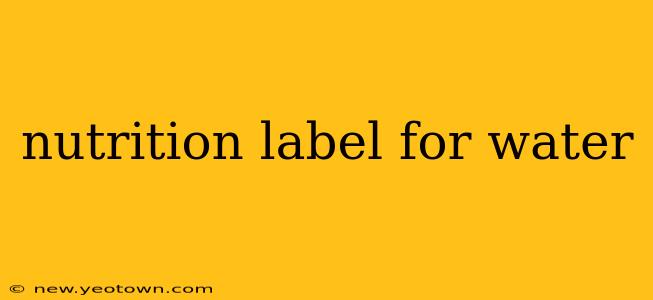Decoding the (Surprisingly Interesting) Nutrition Label for Water
Let's be honest, we often grab a bottle of water without a second thought. It's clear, refreshing, and essential for life. But have you ever really looked at the nutrition label? I mean, really looked? It's surprisingly less boring than you might think, and understanding what’s (or isn't) on it can offer a fascinating insight into the world of food labeling and the purity of our water sources.
This seemingly simple label actually tells a story – a story of regulations, purity standards, and the journey of water from source to bottle. So let's dive in!
What's Typically Not on a Water Nutrition Label?
Most of us expect to see calories, fat, carbohydrates, and so on. But water's label is remarkably different. This is because water itself contains zero calories, fat, carbohydrates, protein, or added sugars. It’s pure H₂O. That's why you won't find a long list of nutritional information like you would on a can of soda or a bag of chips.
What You Might Find (and What it Means)
While a comprehensive nutrient panel is absent, there is still information to be gleaned from a water bottle's label. Depending on the type of water (spring, purified, mineral), you might find details like:
-
Source Identification: This is crucial. The label will specify the source of the water – whether it's a spring, well, or municipal source. This information helps you understand the origin and potential mineral content.
-
"Purified" or "Distilled": These terms indicate that the water has undergone a purification process to remove impurities. "Purified" often means it's been filtered to remove contaminants, while "distilled" suggests a boiling and condensation process.
-
Mineral Content: If it's mineral water, the label will list the amounts of various minerals like calcium, magnesium, and sodium. This information is especially helpful for those looking to supplement their mineral intake.
What About Added Minerals or Flavors?
This leads us to another important consideration: flavored waters or waters with added electrolytes. These products will have nutrition labels similar to other beverages, listing added sugars, sodium, and the specific minerals included. Always check these labels if you're watching your sugar or sodium intake.
Why is there No "Nutrition Facts" Panel on Water?
This question brings us back to the basics. Water, in its purest form, provides no calories or macronutrients. The FDA's regulations for nutrition labeling focus on foods that provide these components. Since water doesn't, it falls outside the typical requirements for a detailed nutrition facts panel.
Does the absence of a detailed nutrition label mean the water is unregulated?
Absolutely not! Water is subject to stringent regulations regarding purity and safety. The Environmental Protection Agency (EPA) and the Food and Drug Administration (FDA) oversee the safety and quality of bottled water, setting standards for contaminants and ensuring the water is safe for consumption.
In conclusion, while the "nutrition label" for water may seem underwhelming at first glance, it's important to understand what is, and isn't, included. It's a testament to the purity of water itself and highlights the different regulations governing it compared to other beverages. So next time you reach for a bottle, take a moment to appreciate the simple, yet powerful, information conveyed on its label – a silent story of purity, regulation, and the journey of this life-sustaining liquid.

